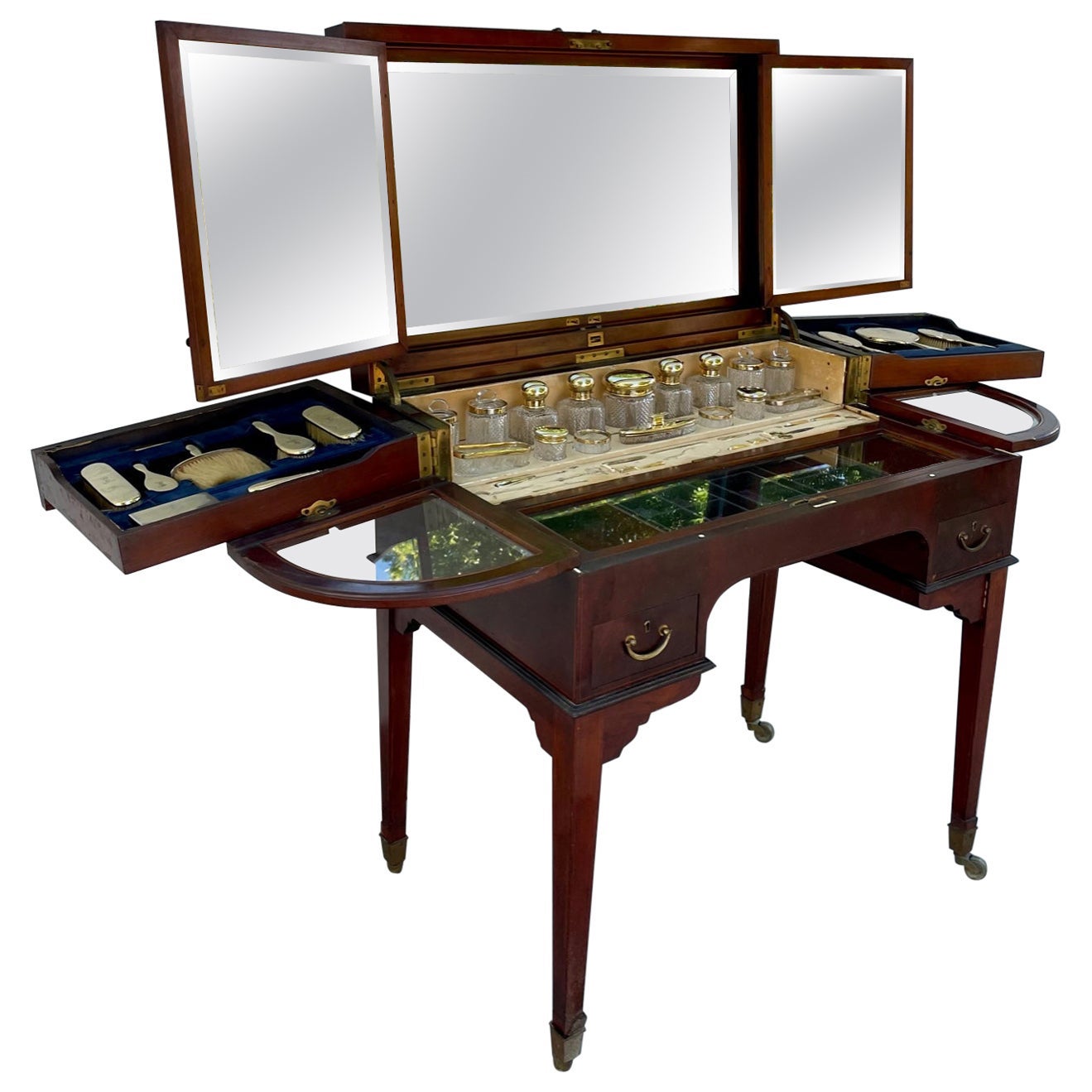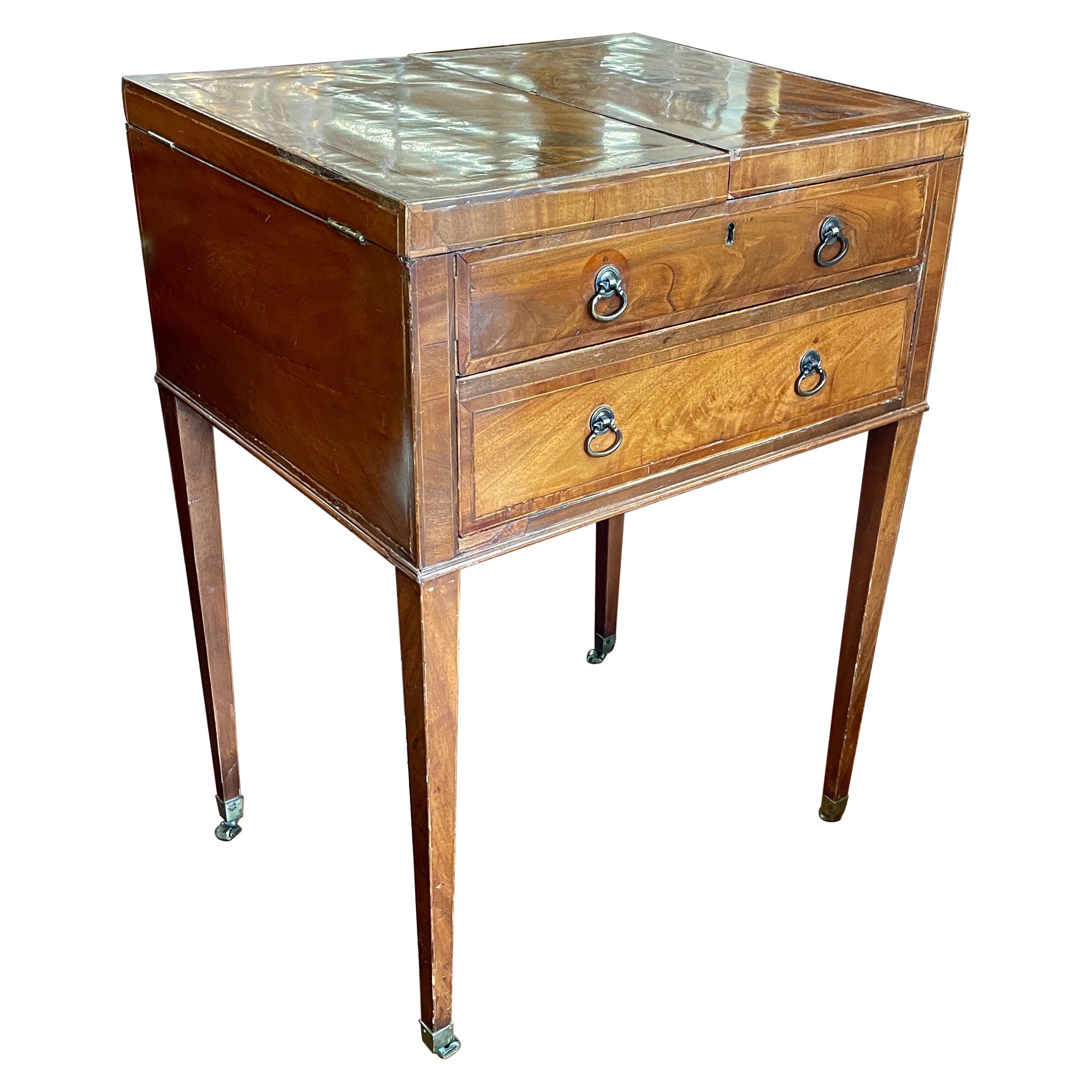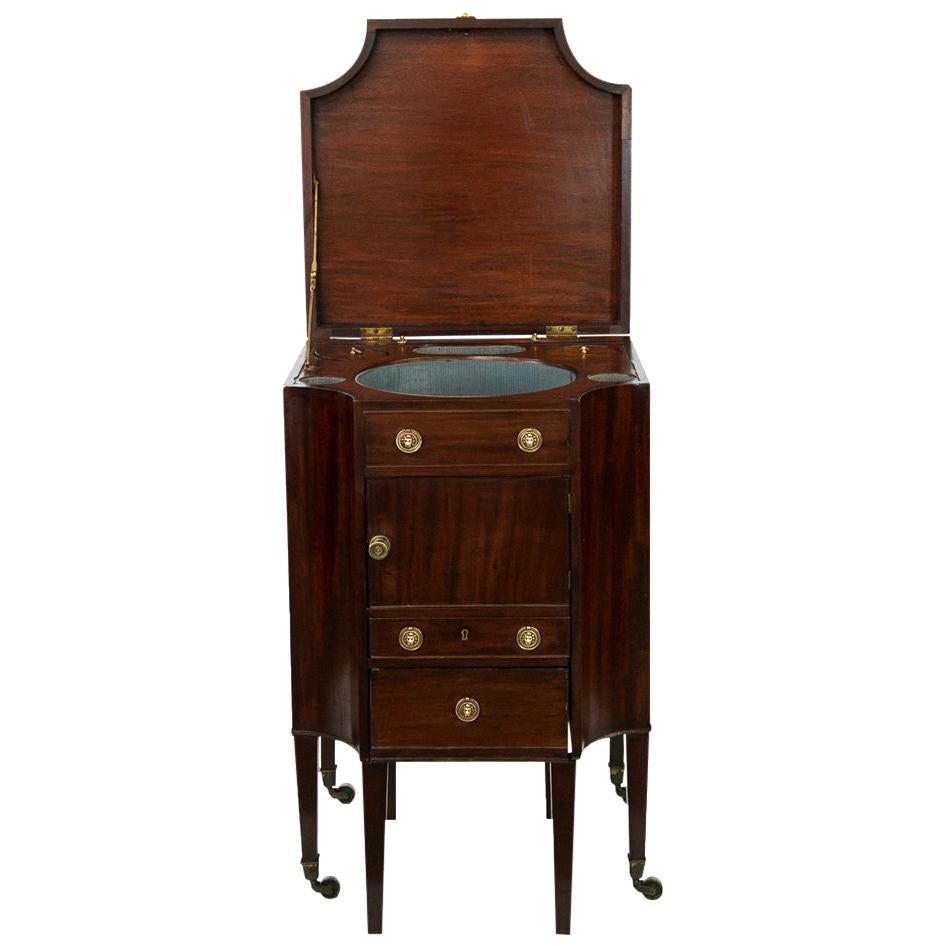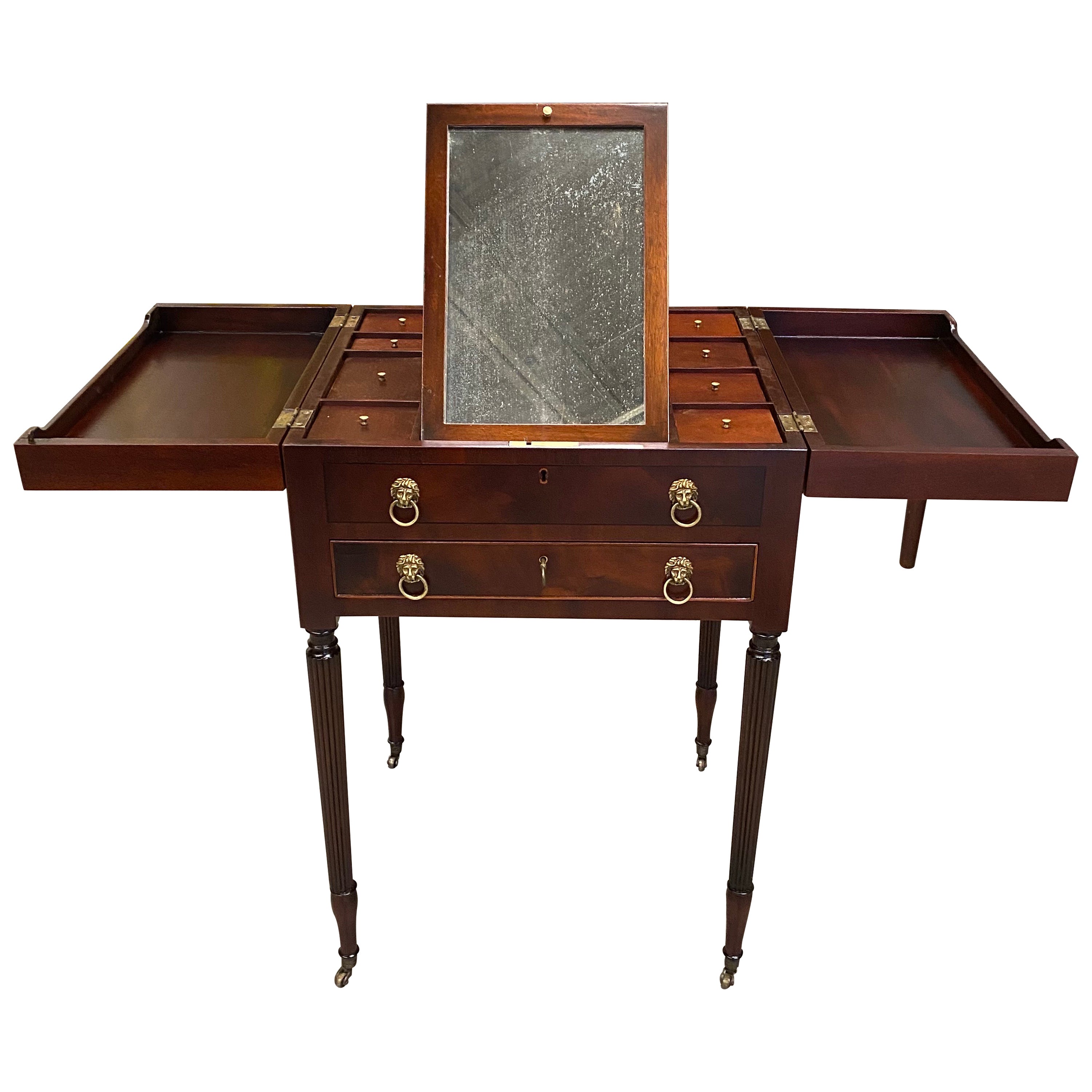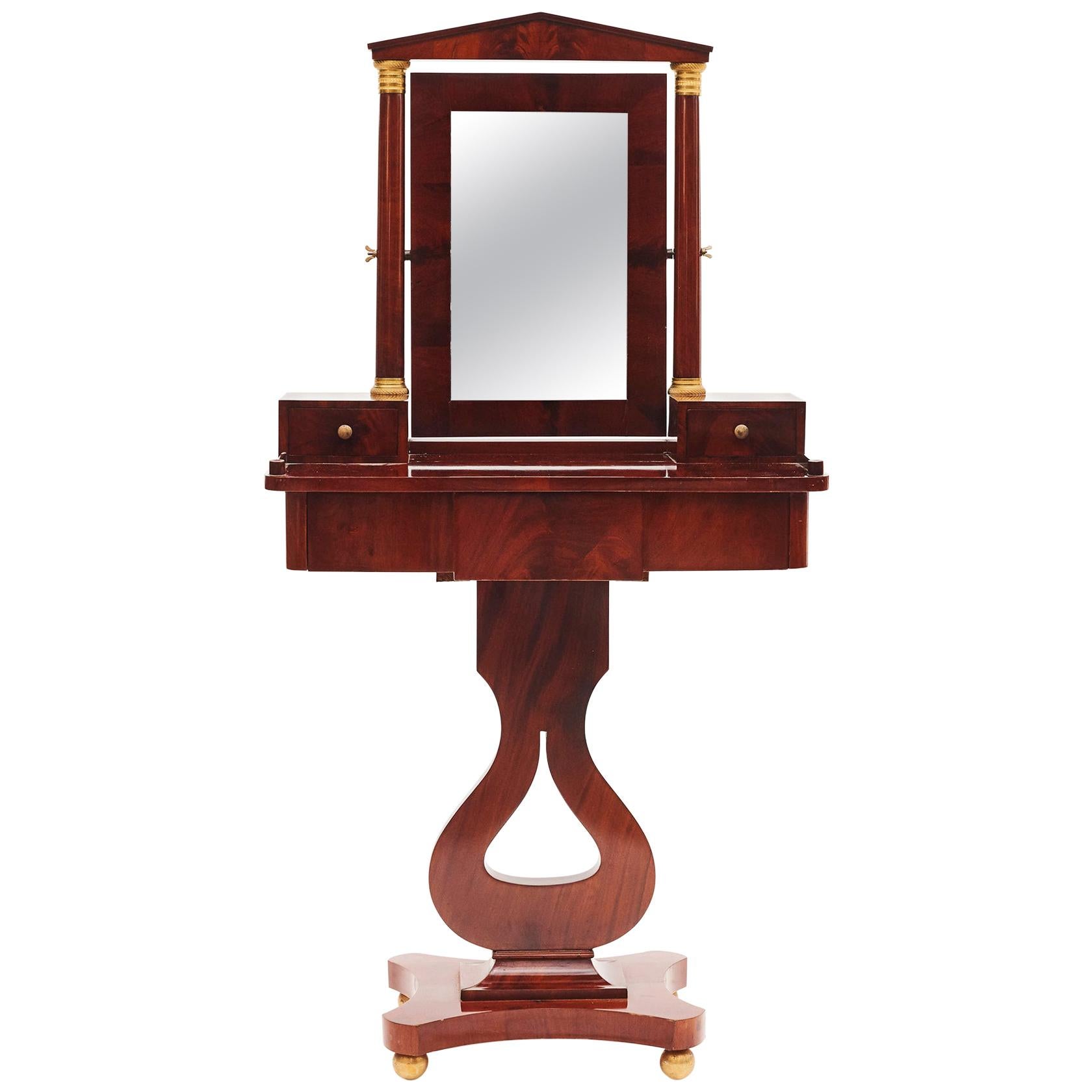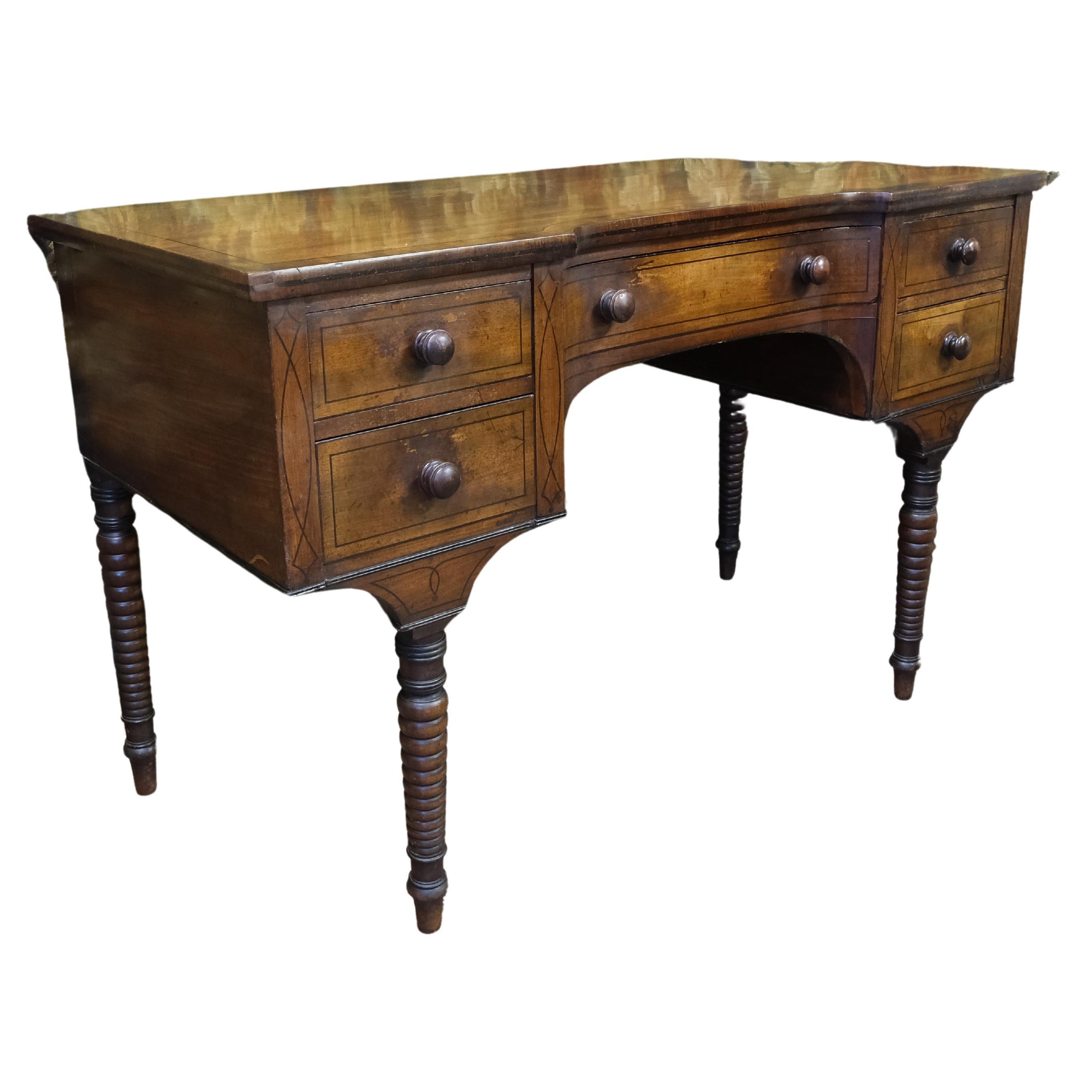Items Similar to Important Beau Brummell Regency Period Flame Mahogany Gentleman's Dressing Table
Want more images or videos?
Request additional images or videos from the seller
1 of 21
Important Beau Brummell Regency Period Flame Mahogany Gentleman's Dressing Table
About the Item
A rare and spectacular George III period (1760-1820) Beau Brummell gentleman's dressing table.
There is no mistaking this remarkably distinctive table's complex design and superb quality, which is certain to attract attention, add interest, and become a conversational talking point wherever you place it. Metamorphic like, the multipurpose piece transforming from a library table or console - vanity - work table - writing desk)
Refined elegant sophistication at its finest, born in late 18th / early 19th century at the height of the George III Regency period, also known as the golden age of classical English furniture design.
Exquisitely hand-crafted of the finest mahogany, having a rectangular top with warm, rich, highly figured swirl - flame mahogany, contrasting satinwood string banding and intricate cross-banded inlays, covered with an optional later glass top, above a trio of drawers affixed with beautiful gilt brass lion pull hardware, the center drawer opening to reveal a divided interior fitted with numerous compartments, richly grained mahogany veneered lids, and a lovely Worcester porcelain desk set.
Above the drawer a pull-out panel with inset green felt functions as both a writing - work surface extension and brushing slide.
Flanking the main drawer, a pair of drawers slide-outward and open to reveal brass hinged large panel mirrors that can also be used to double the work surface, when lifted the mirrors can rotate and additional lidded storage compartments are revealed, including a pin cushion for sewing, horse hair bristle brush, and divided slots coin compartment.
Having elegant clean lines, simple apron, highest-quality reinforced drawers to support the additional weight and allow them to fully extend, all rising on tapered square legs, terminating in patinated brass capped feet with casters.
Dimensions: (approx)
29.5" High, 44.5" Wide, 25.75" Deep (table form)
Provenance:
From the Collection of Gloria Monnet Nicholson, Tulsa, Oklahoma
Acquisition:
Acquired from highly reputable auction house Heritage Auctions, Dallas, Texas. June 2022 Fine Furniture & Decorative Arts Signature Auction #8085 catalog.
Who was Beau Brummell:
George Bryan "Beau" Brummell (1778–1840) was an important figure in Regency England and, for many years, the arbiter of men's fashion. At one time, he was a close friend of the Prince Regent, the future King George IV, but after the two quarrelled and Brummell got into debt, he had to take refuge in France.
Brummell was remembered afterwards as the preeminent example of the dandy, and a whole literature was founded upon his manner and witty sayings, which have persisted until today. His name is still associated with style and good looks and has been given to a variety of modern products to suggest their high quality.
Brummelliana: In literature, Brummell has been more extensively portrayed. Scarcely had he left England than he was satirised as the witty Bellair in the picaresque novel Six Weeks at Long's, by a Late Resident (1817), now ascribed to Eaton Stannard Barrett. Among his humorous remarks there, he is credited with denouncing the eating of vegetables and, when challenged whether he had ever tried it, replying, "Oh, yes, I remember I once ate a pea." A collection of the witticisms ascribed to him and of anecdotes about him followed under the title Brummelliana was republished many times in the following decades. This began with the story of him enquiring the identity of his companion's "fat friend", and also included his "I once ate a pea" remark. William Hazlitt borrowed the same title, "Brummelliana", for an unsympathetic essay published in 1828, referring to some of these stories and repeating others uncollected there. Dandyism also came under attack in George Robert Wythen Baxter's satirical essay "Kiddyism", published in humorous journals from 1832 onwards, which culminates in a set of satirical aphorisms purporting to be yet more Brummelliana. Further fictitious aphorisms were published in France by Honoré de Balzac in the course of a series of articles published under the title Traité de la vie élégante (1830). These sayings were supposed to have arisen during an interview with Brummell in Boulogne, rather than Calais, and epitomise his view of "the elegant life". Brummell is also remembered through numerous published literary portrayals.
Condition:
Very good antique condition, especially considering its well over 200 years old. Beautifully aged mellow patina. Stable and functional.
Detailed Condition Report:
Wear consistent with age and use. Retaining original antique character, including minor scattered losses to veneer, with areas of age splits, blistering, and past restorations to table. Small area of missing brass trim to rear. Areas of blushing to finish of tabletop and deterioration around edge of table evident when glass is removed
Various minor chips and professional restoration to porcelain inkwell and pen holder.
Overall a wonderful example, in great shape, with nothing that detracts from the display or functionality, but only adds to the elegant warmth and rich historical depth that can only be aquired over long periods of time.
Delivered cleaned, waxed, with hand rubbed polished French patina finish, ready for immediate use and generational enjoyment!
- Dimensions:Height: 29.5 in (74.93 cm)Width: 44.5 in (113.03 cm)Depth: 25.75 in (65.41 cm)
- Style:Georgian (Of the Period)
- Materials and Techniques:Brass,Glass,Mahogany,Porcelain,Satinwood,Cross-Banded,Hand-Crafted,Inlay,Veneer
- Place of Origin:England
- Period:Late 18th Century
- Date of Manufacture:Late 18th-Early 19th Century
- Condition:Wear consistent with age and use. Minor losses. Minor fading. Please see detailed condition report within the description.
- Seller Location:Forney, TX
- Reference Number:1stDibs: LU5977229847462
About the Seller
4.8
Platinum Seller
These expertly vetted sellers are 1stDibs' most experienced sellers and are rated highest by our customers.
Established in 2013
1stDibs seller since 2021
200 sales on 1stDibs
Typical response time: <1 hour
- ShippingRetrieving quote...Ships From: Forney, TX
- Return PolicyA return for this item may be initiated within 7 days of delivery.
More From This SellerView All
- Early 19th Century French Empire Period Bureau a Cylindre Gentleman's DeskLocated in Forney, TXA exceptionally rare Period French Empire (1804-1814) walnut bureau a cylindre. Exquisitely hand-crafted in France, most likely Parisian work, dating to the early 19th century, the large antique cylinder desk...Category
Antique Early 19th Century French Empire Desks and Writing Tables
MaterialsBronze
- Antique Japanese Meiji Period Elaborate Flying Dragon TableLocated in Forney, TXA magnificent antique Japanese powerfully carved center table with dragons from the Meiji period. The growth of urban centers and spread of wealth during the Meiji Restoration period in Japan ushered in an era that reveled in the aesthetic qualities of objects and actions in everyday life. This ornately carved figural table from the late 19th century / early 20th century demonstrates the level of pleasure and luxury pursued by the wealthy. The mythical dragon-inspired shape echoes throughout the elaborately hand carved ebonized hardwood; with an unadorned inset polished circular rich rosewood colored top with attractive wood graining; scalloped border and edge with ornate running ornamentation between; rises over the profusely carved and stylized skirt with carvings of whimsical dragon mask and spread wings in high relief and open scrollwork; raised on four spoon carved...Category
Early 20th Century Asian Meiji Tables
MaterialsRosewood
- Early American Classical Empire Period Flame Mahogany Sewing Stand Work TableLocated in Forney, TXA rare fine quality Federal period American Empire flame mahogany sewing stand work table from the early 19th century. Exquisitely hand-crafted in the northeastern United States, most likely Philadelphia, Pennsylvania, circa 1820, having a hinged top, opening to reveal contrasting Birdseye maple marquetry oval cartouche inlay, a fitted maple divided compartment interior, the front having two nicely shaped curved drawer fronts, consisting of a faux drawer front over a single dovetailed ogee drawer, above a vasiform pedestal standard, molded stepped platform base, rising on bracket feet, resting on casters. Attractive highly figured crotch cut swirl mahogany with striking grain patterns, rich and deep antique wood color...Category
Antique Early 19th Century American Empire Side Tables
MaterialsBirdseye Maple, Mahogany
- 18th Century Spanish Baroque Period Carved Walnut Geometric TableLocated in Forney, TXA remarkable one-of-a-kind Spanish Baroque Period hand carved walnut table with beautifully aged warm rustic distressed patina. Hand-crafted in Spain in the first half of the 18th century, with later architectural elements, having a rectangular single board plank top with breadboard batten ends and desirable overhang, above deep geometric pattern carvings to three sides of the apron and chip carved running ornamentation to the back, elevated on tall hand turned legs. A wonderful way to add authentic antique character, rustic warmth, and European old world charm! Dimensions (approx) 32" Tall, 56.5" Wide, 27" Deep As warm and attractive as it is useful, having the ideal large size and proportions for a variety of different uses, including as a Mediterranean Revival dining sideboard server - buffet table...Category
Antique 18th Century Spanish Baroque Tables
MaterialsWalnut
- 19th C. French Charles X Restoration Period Sewing Stand Work TableLocated in Forney, TXA scarce period Charles X (1818-1834) French Restoration mahogany travailleuse sewing (thread stand - side table - jewelry dressing table) with light, warm, beautifully aged patina. Born in France in the early 19th century, almost certainly Parisian work, exquisitely hand-crafted, this exceptionally executed example features ornate gilt bronze ormolu mounts, escutcheons, and elaborate gilt metal trim. Having a highly figured light mahogany hinged lid top, lifting open to reveal a striking finished interior with divided compartments and original inset mirror plate. The conforming rectangular case fitted with a faux drawer front over a dovetailed drawer with sectioned interior. Elegantly rising on oval-shaped medial shelf stretcher-joined curvacious legs. Dimensions (approx): 27" High, 20" Wide, 13.5" Deep Stunning light almost blonde antique mahogany coloring and mellow warm tone, superb wood grain detail, and charming, beautifully aged patina over the whole. Great shape overall. Retaining original antique character marks, wear consistent with age and indicative of minimal use, nothing that detracts from the aesthetics or functionality, but only adds to the overall authenticity, refined elegant warmth, luxurious sophistication, and cozy unpretentious rustic elegance. Delivered cleaned, hand waxed, polished French patina finish, ready for immediate use and generational enjoyment! What is Charles X style: The comte d’Artois – or Charles X - was the son of the dauphin Louis-Ferdinand de Franc and Marie-Josèphe de Saxe. He succeeded his two brothers Louis XVI and Louis XVIII and became the King of France in 1824. Thirty years after the French Revolution, he wanted to embody the return of monarchy and became the leader of the catholic party . As the previous kings, he was crowned in 1825 but he was soon overthrown by the revolution in July, 1830, called "Trois Glorieuses". He left then for England, Scotland, Prague and Istria where he died in 1836. Charles X style lasted from 1818 to 1834 and happened during the Bourbon Restoration (French Restoration). This style did not replace totally the style of furniture from the French Empire but it was different from the formalism in the Napoleonic era, during which strictness and simplicity were inspired by Greco-Roman art. Indeed, artistic fields flourished. In terms of furniture, this renewal was suggested by the softening of shapes. Even though the simple aspect from the French Empire was still visible, shapes became curvier with volutes and arabesques. Another distinction is the loss of the massive aspect of furniture and the decrease of dimensions in order to decorate smaller appartments. Handling ability and comfort were key-words in the making of furniture. Apartments had essential elements such as chests of drawers, big rounded tables in the dining room, desks or secretaries, armoires and even dressing tables, comfortable fainting couches in the living room, small tables, pedestal tables, as well as gondola chairs. The wavy aspect of the latters certainly represent Charles X style the best. One of the most emblematic features of this style is the use of bois clairs – light woods in warm blond tones - and indigenous woods that are varnished in order to highlight the grains. Bird's-eye maple, ash trees, plane trees, yew trees, beech trees, olive trees and cedar trees were most likely to be used. Indeed, at the beginning of the 19th century dark woods were hard to find. In 1806, the Napoleon’s Continental System was established in order to ruin the United Kingdom by preventing the country from any business with the rest of Europe. Therefore craftsmen had to find alternatives from mahogany which was the most commonly used material at this time. After 1815, the import of wood was even more difficult because of peace treaties and the European political situation, which contributed to the popularity of the bois clairs and indigenous woods. The furniture was often decorated with fine inlays made out of dark wood representing foliage, which contrasted with the veneer. Even though these patterns can look like bronze decorations from the Empire era, they were far more simple and did not represent any military or mythological attributes. On the tables, trays were sometimes made out of marble as in the French Empire, but it was often put aside and inlaid veneer, Verre Eglomisé – a type of glass with a mirror finish –, mirror or porcelain from Sèvres or Paris were more likely to be used. Decorative elements from the Monarchy were highly appreciated again as they suggested luxury. Indeed, marquetry work was particularly fashionable - Boulle marquetry thrived around 1820 as the works of the Levasseur family can show. In the same way, draperies and trimmings referred to the monarchist splendour. Fabrics were often white – the traditional colour of the Bourbons – or light coloured as oppposed to the typical green from the Napoleonic era. One of the most symbolic figures from this period of time might be Jean-Jacques Werner (1791-1849), a cabinetmaker who worked for prestigious clients such as the Duchesse de Berry who was Charles’s step-daughter. His works can be seen at the Musée des Arts Décoratifs and at the Grand Trianon in the Palace of Versailles. The duchess’s appartments situated at the pavillon de Marsan and at the Palais de Saint Cloud illustrate Charles X style the best with furniture made out of bois clairs and ornamented with dark wood patterns or fine gold decorations. Chales X style allows a transition between the sobriety of the Empire style and the abundant aspect of Louis-Philippe style. The gothic style started at this time through the "style à la cathédrale", inspired by religious architecture, which thrived from 1827 to 1830. Indeed, at the beginning of the 19th century, Romanticism put the spotlight on the Middle Ages. Cabinetmakers were not inspired by the medieval furniture but rather by architectural elements of churches and cathedrals. For instance the backs of chairs were decorated with arches shaped like rib and serration. In the same way, before Charles X abdicated, pieces of furniture were made out of dark woods – such as mahogany, which was used again in France – and were inlaid with light wood. Romanticism also influenced the layout of furniture in appartments to suggest movement through a mix of various styles, various shapes and various sizes, as opposed to the static aspect of Neoclassicism. The start of industrialisation and mechanisation also influenced this style as early technical developments led to the production of pieces of furniture in series. Credit: Marc Maison Bibliography: FANIEL Stéphane (Dir.), Le Dix-neuvième Siècle Français, Collection Connaissance des Arts, 1957, Hachette SASSONE, Adriana Boidi, Furniture from Rococo to Art Deco, 2000, Evergreen -- Extremely versatile: As warm and attractive as it is useful, this remarkable antique table having the ideal size and small proportions for a variety of different uses, including as a side table, accent or occasional table, tall sofa...Category
Antique Early 19th Century French Charles X End Tables
MaterialsBronze, Ormolu
- Mid-19th Century Danish Empire Mahogany Games TableLocated in Forney, TXAn elegant Danish antique, circa 1850, inlaid mahogany games table. Restored in the recent past, retaining antique character marks throughout, dark rich patina, and luminous sheen. ...Category
Antique Mid-19th Century Game Tables
MaterialsBrass
You May Also Like
- English Mahogany Beau Brummell Gentleman Dressing Desk, Aristocratic PedigreeBy Maple & Co.Located in Vero Beach, FLEnglish Mahogany Beau Brummell Gentleman dressing desk. Aristocratic Pedigree. Outstanding example of a rare mechanical piece of furniture of museum quality. The luxurious polished Mahogany desk is raised on four square tapered legs on brass casters. Beautiful proportions give it a regal appearance. This elaborate and ingenious construction is master crafted by the cabinet maker, Maple Company of London. A spring-loaded mechanism lifts the top to reveal a triptych beveled mirror and a spectacular display of a multitude of hallmarked Vermeil silver and cut crystal vanity suites by Charles and Richard Comyns. Every piece is fully hallmarked and engraved with the crown of a count and monogrammed. The desk has it’s original finish, pencil inlay and original brass hardware, like hinges and catches. This statement piece represents the modern concept of glamour and luxury. Maple and Company of London furnished Tsar Nicholas’s Winter Palace and the Hofburg Imperial Palace in Vienna among other Royal Houses. This dressing vanity desk from the turn of the century is from the estate of the American actor and Real Estate millionaire Percy Garnett Williams (1857-1923) Condition: Original antique surface...Category
Antique Late 19th Century English Regency Vanities
MaterialsMahogany
- English George III Inlaid Mahogany Gentleman's Dressing Table or Beau BrummelLocated in Charleston, SCFabulous quality rare and important antique English George III inlaid flame mahogany Gentleman's Dressing Table or Beau Brummel. This table...Category
Antique Early 19th Century English George III Vanities
MaterialsMahogany, Bone
- English Mahogany Dressing TableLocated in Wilson, NCThis dressing table has shaped convex corners. The top lifts up to expose working compartments lined with fabric over paper of which the back two have lids. There is a solid mahogany...Category
Antique Early 1800s English Vanities
MaterialsBrass
- A Regency Style Carved Mahogany Beau Brummel Gentlemans Vanity DeskLocated in Lambertville, NJA Regency style carved mahogany Beau Brummel gentleman's dressing table, 20th century, the hinged top enclosing nine lidded compartments about a folding m...Category
Antique Early 1900s Desks
MaterialsLeather, Mahogany
- Swedish Biedermeier Mahogany Dressing Table, circa 1820Located in Kastrup, DKSwedish biedermeier / late empire mahogany mirrored dressing table. Swing mirror supported by gilt fluted columns, lyre shaped pedestal on brass ball feet. Sweden, circa 1820.Category
Antique Early 19th Century Swedish Biedermeier Vanities
MaterialsBronze
- Regency mahogany dressing tableLocated in Cheltenham, GBHutton-Clarke Antiques is thrilled to showcase a distinguished and rare Regency Dressing Table from circa 1800, boasting exquisite craftsmanship in fine mahogany with solid drawer li...Category
Antique Early 1800s European Regency Vanities
MaterialsMahogany
Recently Viewed
View AllMore Ways To Browse
Large Vanity
Antique Vanities For
High Vanity
Antiques Antique Vanity
Antique French Vanity
French Antique Vanity
Antique French Vanities
Antique Vanity Top
Dallas Used Furniture
An Antique Vanity
Brass Dressing Table
Dressing Set
Dressing Table England
Antique Dressing Vanity
Glass Dressing Table
Mahogany Dressing Table
Mahogany Dressing Tables
Dressing Table With Legs
